We are just out of April and the baseball world has already experienced its fair share of disappointments and surprises in 2014. Managers have been thrown out of games for arguing about the results of replay calls, the transfer rule has been visited and revisited, the new home plate rule has been a source of irritation and confusion for some players and managers, some players are headed for career years while others have yet to play while rehabbing from injury.
However, some things never seem to change. For instance, in 2014 we have seen a disturbing trend continue – injuries caused by head first slides.
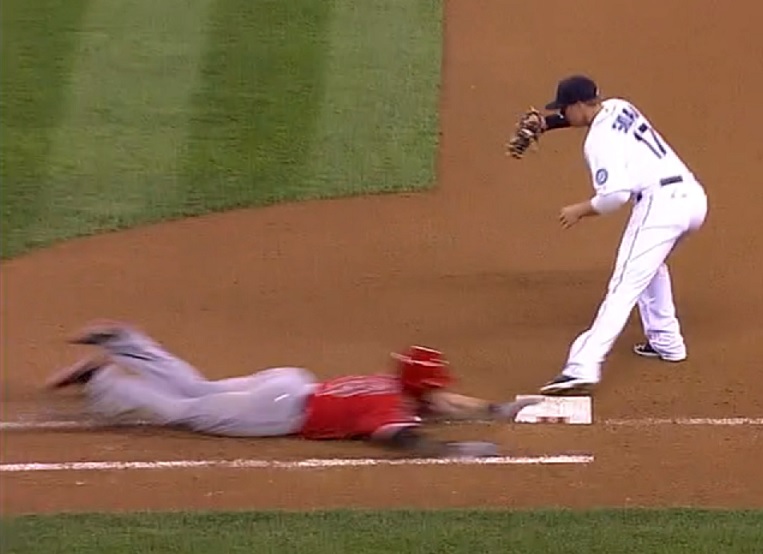
Josh Hamilton’s head first slide into first base on April 8 will cost him 6 to 8 weeks on the DL and cost the Angels a lot of money. (Video capture courtesy of MLB.com)
A quick check reveals the following incidents in the first month of the season alone:
- April 4: Billy Hamilton ordinarily slides feet first on most of his steal attempts. However, during this game he went in head first and jammed the middle finger on his left hand. He was listed as day-to-day and was caught stealing on the play. Hamilton reported: “I got a bad jump. I slide head first when I know I’m in danger of getting thrown out. It’s pretty swollen. It hurt too much to swing.”
- April 5: Yasiel Puig made a head first slide into first base on an infield hit. He jammed his left thumb requiring an MRI and missed two games. This was not the first time that Puig has slid head first into first base and probably won’t be the last.
- April 8: Josh Hamilton’s ill-advised head first slide into first base resulted in a complete tear of the ulnar collateral ligament in his left thumb along with a torn capsule. His injuries, which required surgery, will cost him 6-8 weeks on the disabled list. In 2011, Hamilton fractured his right humerus (the long bone of the arm that runs shoulder to elbow) in a diving head first slide at home plate.
- April 22: Dee Gordon, on his 26th birthday, stole third base. As usual he went into a head first slide. He lost his helmet and his head hit the left knee of third baseman Jayson Nix. After being checked out for possible concussion Gordon was able to continue in the game. In July 2012 Gordon tore the ulnar collateral ligament in his right thumb on a head first slide. He required surgery and missed six weeks of action.
- April 25: Bryce Harper‘s head-first slide into third base will likely cost him at least two months of playing time as surgery is required to repair a torn ulnar collateral ligament in his left thumb.
Most likely because I am not a proponent of the head first slide, I am more aware of these incidents than any injuries resulting from feet first slides. We certainly know that any time a player hits the ground or grass he is in danger of injuring himself whether from sliding into a base, diving to make a defensive play or even throwing himself to the ground as a hitter to avoid an inside pitch. However, one has to ask if the reward of a head first slide outweighs the risks to fingers, wrists and heads.
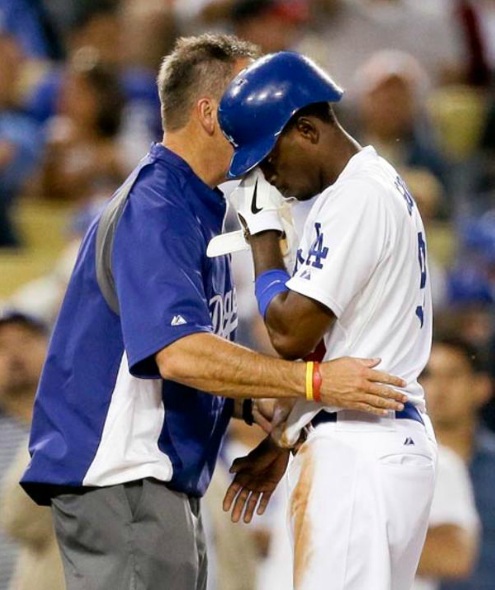
Dee Gordon missed much of the 2012 season when he tore the ulnar collateral ligament in his right thumb on a head first slide into third base – something that he continues to do to this day. (Photo credit – Chris Carlson)
Because it is so very difficult to control the variables it is almost impossible to conduct quality scientific experiments to determine which is the the better slide – head first or feet first. In addition to that the scientific world really hasn’t embraced sliding as a very worthy area to study. There is a large body of scientific research on the curveball but very little on sliding.
Some research does exist and some laws of physics have been applied to the slide. David A. Peters , Ph.D. of the McDonnell Douglas Professor of Engineering at Washington University in St. Louis, is a big-time baseball fan. Perhaps those players sliding into first base should heed his advice. Peters says the only advantage of any slide into first base is to avoid the first baseman’s tag when he has to come off the base to spear an errant throw. Sliding does not get a player to first base more quickly.
Peters concludes: “Mathematically, you might think there’s an advantage, but leaving your feet is actually a detriment because you’re no longer pulsing (pumping your legs) and you start to decelerate,” he says. “When you’re running, your get your feet out in front of the center of gravity, so you’re getting maybe three or four steps of an advantage.” If sliding caused an athlete to accelerate then one suspects sprinters would slide across the finish line rather than stretch forward lowering their center of gravity. The slide into first base is simply not a very good idea.
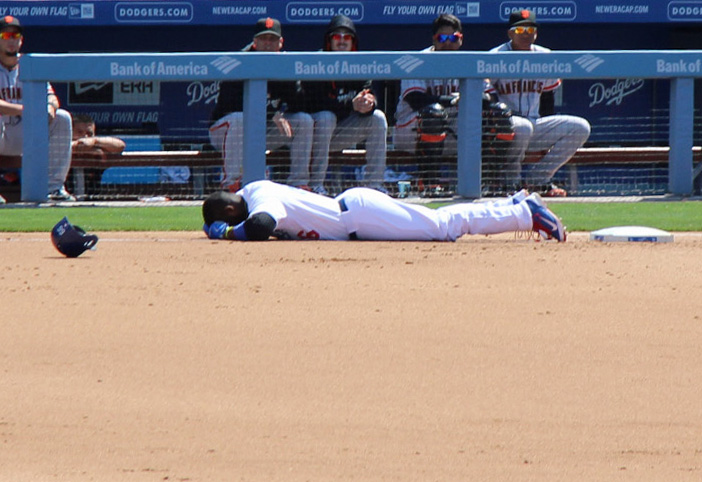
Yasiel Puig was extremely fortunate that he only missed two game after jamming his right thumb on a completely unnecessary head first slide into first base. (Photo credit – Ron Cervenka)
With sliding into first base being a low reward/high risk type of play, what about the head first slide into the other bases? The research is scant and inconclusive as to whether the head first of feet first slide is faster. Dr. Peters postulates the following: “It turns out your center of gravity is where the momentum is,” Peters says. “This is found half way from the tips of your fingers to the tips of your toes. In the headfirst slide, the center of gravity is lower than halfway between your feet and hands, so your feet don’t get there as fast. It’s faster head-first.”
A study by the American Journal of Sports Medicine used a total of 60 players ranging from Little League to college level and analyzed the results of head first and feet first slides under controlled conditions. Although I personally believe the conditions cannot be replicated on each trial, the study is of interest. The conclusion: “We found no statistically significant difference in speed between head-first and feet-first sliding at all levels of play in this study.”
Brandon Keim in an article, “Physicists Say Head First Slide to Base Faster, Maybe” reports that in three published studies to test the physicists’ hypothesis, none found a significant headfirst advantage, and one a disadvantage. He also reported: “One study did find that head first sliders reached second base .02 seconds faster. Back-of-the-napkin calculations show that a runner traveling at 15 miles per hour would get an extra five inches from that .02 seconds — and in the legendary words of Branch Rickey, “Baseball is a game of inches.“
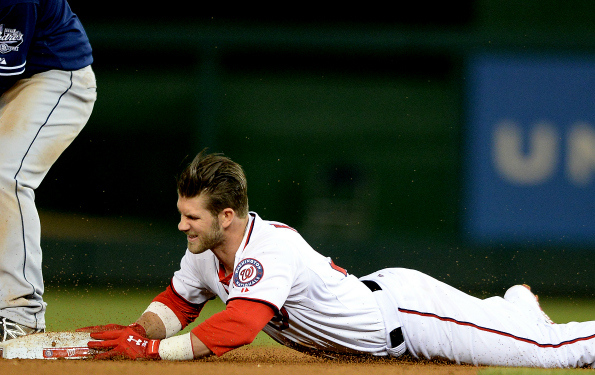
Bryce Harper will be lost to the Nationals for two months after his head first slide on April 25 cost him a torn ulnar collateral ligament in his left thumb. (Photo credit – Patrick Smith)
So what’s a fellow to do? Scientists disagree on the advantages of a head first slide as do knowledgeable baseball people. I expect it is back to weighing the possible reward against the possible risk.
Inaugural Hall of Famer Ty Cobb had an interesting perspective on the head first slide as opposed to feet first slide.
“In my own base running I started out as a head first slider but was cured of it on my second day in the big leagues. I tried to steal second and went in head first against Kid Elberfeld, the tough little shortstop of the old Highlanders. He politely brought his knee down on the back of my neck and my forehead went smashing into the dirt, leaving most of the skin behind. I never tried it again. In fact the very next time I went into second against Elberfeld, I slid feet first, caught him by surprise and knocked him sprawling. Since players in the golden era could take it as well as dish it out, the Kid patted me on the back and said ‘That’s the way to play, sonny boy.’
“After learning to slide feet first I soon learned something else,” Cobb continued. “By watching the eyes of the man covering second, as he waits for the throw, you can tell where the ball is coming from and aim your slide in the other direction to stay as far away from the tag as possible. Then I learned to watch the third baseman’s eyes on plays at that bag, especially if the throw is coming from right field. You can line your body up with it as you approach the bag and try to let it hit you. If you’re lucky enough to have it carom off one side of your body, you may make it all the way home. Even if the ball doesn’t hit you, at least you get in the third baseman’s line of vision.”
It’s no wonder that Cobb was one of the greatest base stealers of all time.
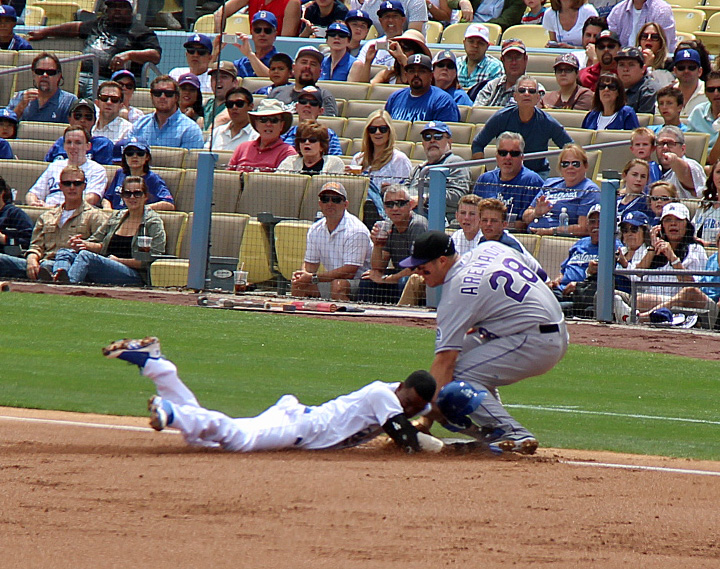
Five days after Gordon took a knee to the head on a slide into third base in which his helmet came off, it happened again. Fortunately, Gordon was not shaken up this time. (Photo credit – Ron Cervenka)
Davey Lopes is widely known as somewhat of a base running guru. As we might expect, Lopes is not a big fan of the head first slide. It is Lopes’ contention that sliding head first does not provide the split-second advantage many players believe it does.
“You watch a lot of head first slides and they’re very long,” Lopes said. “If I’m getting one more stride in going feet first, I’m going to get there faster. It’s a matter of what you find comfortable. But I will say this – if you continue to do head first slides, it’s likely going to come back to bite you in the butt.”
Lopes, in fact, saw Rafael Furcal get hurt up close on a play that seemed to validate his opinion. Furcal went in head first on a steal attempt and San Francisco third baseman Pablo Sandoval dropped his knee to block the base. Furcal slid into Sandoval’s knee and broke his thumb resulting in several weeks on the disabled list.
Maury Wills perfected the hook slide, pulling his body away from the potential tag and clipping the corner of the bag. It is rarely seen now and even when you think you’re seeing one, Wills concludes it’s not necessarily the real article. Jackie Robinson made the hook slide famous using it frequently to avoid tags.
The head first slide is becoming more and more prevalent in the game and the debate over it versus the feet first slide will undoubtedly rage on. And even though there are now several different types of hand armor available as pointed out in a July 5, 2012 article here on Think Blue LA, few, if any, wear it on both hands and they most certainly don’t have it on when head first sliding into first base.
Maybe Ricky Henderson, the greatest base stealer of all time, should have the last word on the head first slide:
“…it just feels faster.”




 May 5th, 2014 at 6:00 am
May 5th, 2014 at 6:00 am  by Harold Uhlman
by Harold Uhlman  Posted in
Posted in 

You obviously went head first into this article Harold. Great job.
One option that I think hasn’t been visited, if at all, is the possibility of re-designing the shape of the base bags to something which might reduce injury. It’s a fine line in creating a base that a guy can slide into without injuring himself, and reshaping the profile of the base to keep hands and thumbs free of injury.
MLB might have something to look into?
Great article, Harold.
As noted above, the only time a guy should slide into first base head-first is to avoid a tag on an errant throw, but even this is hard to detect when running down the first base line, just as it is running to second and third.
I had never heard that Ty Cobb story before and it clearly shows the advantage of staying upright so that the base runner can watch the eyes of the infielder receiving the throw to get an idea where the ball will be caught. Granted, we’re talking milliseconds here, but this is something that you never hear about (although I bet Wills and Lopes know about it).
I imagine that we will never see an end to head-first slides – especially when the greatest base stealer of all time endorses it.
Catchy title, eh!
Very nice article Bluenose, I really enjoyed it. I notice that there is a lot more sliding in baseball now than 50 years or so ago. Not only more head first sliding into the bases but just simply making the sliding catch in the outfield. Everybody seems to be sliding now. I played mostly on concrete and there wasn’t much there.
Speaking of the head first slide, I have to agree with you. At first I thought that it helped the slider but regardless of whether it does or not there’s been just too many injuries lately. BUT the injuries don’t scare off these guys and as you pointed out it looks like they’ll continue to do so. I think players ought to learn to slide the proper way when they are just starting out as kids in the Little Leagues.
The head first slide, in my opinion, may well take away an extra base away as the runner takes longer to find the ball if there is an offline throw or missed catch. It takes away the pop up slide also.
In any event, I expect players will slide as they are comfortable doing. I do think teams should clamp down on slides into first base being permitted only on an errant on the home plate side of first base. The head first slide into home, never a great idea, is safer now with the new blocking the plate rules. However, there is still the distinct possibility of going head first or hand first into the catcher’s shin guards as he moves towards the runner to make a tag.
ICYMI – To slide or to dive? – The (multi) million dollar question – http://t.co/trqAL6D9rJ
Top Twins prospect Byron Buxton injured his left wrist Saturday sliding into third base in a minor league game. Any guesses as to how he slid into third jamming his previously injured left wrist? It wasn’t feet first.
Ben Zobrist dislocated his thumb sliding into second base yesterday – head first. What can we say?